Peiresc, humanist genius of Provence
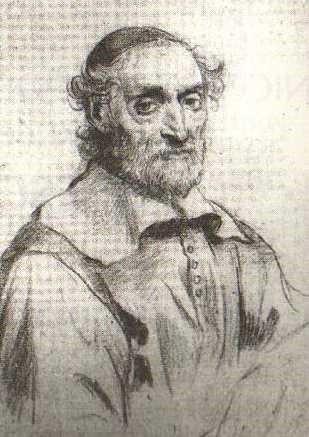
Peiresc, engraving by Claude Mellan, Hermitage Museum, Saint-Petersburg
Nicolas-Claude Fabri, Lord of Peiresc, was born on December 1st 1580 on his family’s country estate of Belgentier, where his parents had escaped to avoid a bout of the plague, as well as the wars of religion then afflicting their home city of Aix-en-Provence. The Fabri, originally from Pisa, had settled in Aix in 1254. His mother died two years after Nicolas' birth, shortly after the birth of his little brother Palamede. The two orphans were raised by their father, Reynaud Fabri, and their bachelor uncle, both dedicated humanists.
They received the best of education. Nicolas-Claude studied philosophy at Aix and Law at Avignon and Montpellier. Together with Palamede, he travelled extensively in Italy for three years, studying at Padua with Galileo. In 1603, both Nicolas and Palamede were made Doctors of Law.
His father then gave Nicolas-Claude the family lands of Peiresc (today Peyresq, largely owned by Belgian universities) high up in the Provençal Alps, where he would never set foot.
Nicolas acted as secretary to the President of the Parliament of Aix, Guillaume du Vair. When the latter is called to Paris by King Henri IV (originally of Navarre) to become Keeper of the Seals (Minister of Justice), Peiresc accompanies him there, also travelling to England and the Netherlands.
In October 1606, he returns to Aix and takes over the office of King's Counsellor to the Parliament from his uncle. He embarks on a life of study, deciding against marriage, turning down a match arranged by his father. He will meet personally many of the great names of his time, and keep up an astounding correspondence, amounting to at least 10,000 letters, with some 500 correspondents. He wrote and spoke with equal ease in French, Latin, Greek and Italian.
Peiresc's network
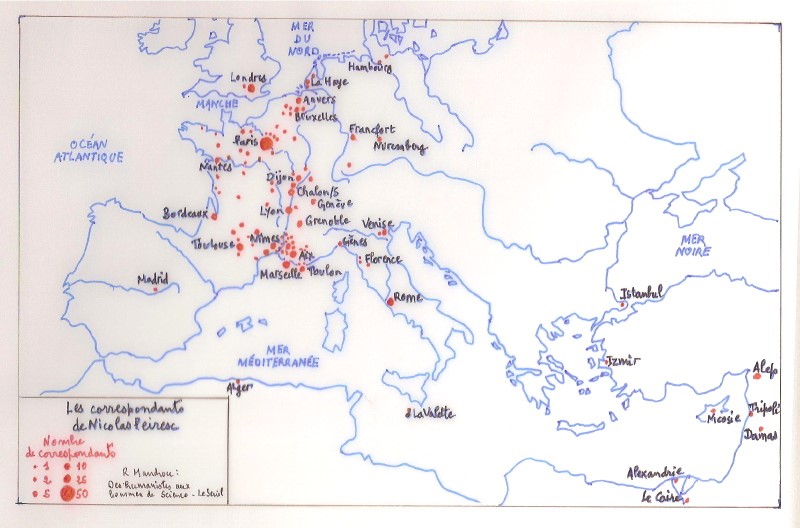
His friend, the astronomer Gassendi, gives of him the following description:
"Of ordinary height, of lean constitution, subject to illnesses (...) Of high forehead, blue eyes often misted with humor (i.e. watery)... The nose slightly crooked, colored cheeks, the hair blonde, as well as the beard which he wore long according to the fashion. One perceived an extreme sweetness and kindness flowing over his face. Most frugal for himself, he was ordinarily splendiferous to others. No one ever gave more willingly, more generously, more often (...) He looked upon the whole world as his family, and upon all the wise as his fathers, brothers, children with whom he had everything in common..."
Chevalier di Pozzo compliments him:
He who has grace in adolescence, erudition in youth and prudence in old age, is in the first of these ages, the delight of his friends, in the second, the honor of his country, in the third, a consolation to himself. You, Fabry, are all three things at once.
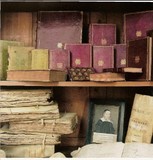
Peiresc lived in the family mansion in Aix, the Hôtel de Calas, near the palace of the Counts of Provence, which he equipped with a cupola for astronomic observations and with a laboratory. There, he received his innumerable friends and kept his 5,402 volume library, his 17,000 item numismatic collection, for the curating of which he learned Hebrew and Coptic, and sundry other collections, such as one of Egyptian scrolls - having a hunch that their deciphering would go through Coptic. The mansion was demolished in the XVIII centry, together with the Countal Palace, to give way to a new Palais de Justice. A street bearing his name (rue Peiresc) roughly indicates the situation of the mansion where he lived and died.
Astronomy
A humanist in the fullest meaning of the term, it was yet in astronomy that his contributions were most eminent. I am quoting from his biography on the site of the Peiresc Planetarium of the University of Aix-en- Provence, named after him, for a list of his achievements in this domain:

- In Octobre 1604 he observes a new star (a supernova), but being on the road, cannot ascertain that it was not already known.
- November 26, 1610, he discovers the Great Nebula of Orion (picture).
- In Novembre 1610, 10 months after Galileo, he rediscovers the satellites of Jupiter. He owns a telescope (then called « lunette de Hollande ») which he had built to his specifications. With true genius – but too much humility – he carries out measurements of the moments of immersion and emersion of Jupiter’s satellites, deducting from them tables which were more accurate than those of Galileo, and which he would not publish. His tables would have permitted a more accurate determination of terrestrial longitudes (he was the first to come up with the idea to use these regular rounds of satellites to determine longitudes). He was first in demonstrating that Jupiter’s satellites satisfy to Kepler’s 3rd law.
- On January 15, 1611 he discovers the star cluster of the “Beehive” or Praesepe, or M44, in Cancer.
- In 1631 he is intend on observing the passage of Mercury in front of the solar disk, but a good meal makes him miss the event.
- In 1635, at the occasion of the Lunar eclipse of August 28, he coordinates observations of the entrance of the Moon into the shadow of Earth. His observers are spread all along the Mediterranean: in Aix (they will fall asleep at the summit of Montagne Sainte-Victoire at the crucial moment), Marseille, Digne, Padua, Venice, Rome, Cesena, Naples, Malta, Carthago, Cairo and Aleppo. The results of this first observation are a success : they « shorten » the Eastern basin of the Mediterranean by 1,000 km.
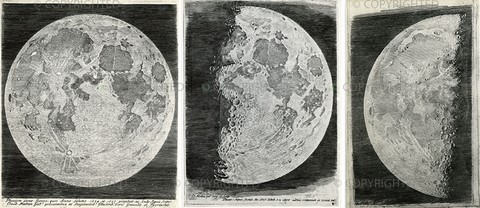
In Defense of Galileo
In many ways, due to the climate of Inquisition of the time, Peiresc practiced some measure of self-restreint in his writings and this may have had something to do with the fact that he published nothing in his life-time.
“He clearly supported Copernician views, as he tried to apply the concept of a rotating Earth to tide theory, the formation of mountains and the structure of Earth. Yet he did not support this view openly, remaining vague and prudent even in his correspondence with Galileo.” *
Did Peiresc lack courage? Certainly not, for:
«... he had the great courage to defend Galileo in an admirable and prescient letter to Cardinal Francesco Barberini (e.g. Rizza, 1961, 1965) the nephew of Pope Urban VIII:*
"Certainly such rigour will be considered excessive for all, and more by posterity than for the present century… It will be a blot on the reputation of this pontificate, if Your Eminence does not decide to take him under your patronage and in particular consideration, as I am imploring you and beseeching you humbly and with the strongest ardour."*
*Gaston Godard, in Martina Kölb-Ebert: Geology and Religion, A History of Harmony and Hostility, The Geological Society, London, 2009.
His very concern for the future of the reputation of the Pope shows well that he judged Galileo's views to be right, and that he was convinced that they would prevail...
Geology, palaeontology
See The Dragon at the bus-stop
He also studied volcanoes extensively and, with Gassendi, tried to arrive at some understanding of the origins of rocks.
Human physiology
Peiresc was interested in the « milky veins » (nowadays called chyliferous vessels) which had been observed on the intestinal wall of dogs and which expand during digestion. In order to discover if those existed in human as well, he took advantage of a sinister opportunity: he recommended that a man condemned to death be well fed right before being hanged: he was then able to verify the presence of these same vessels.
He also studied the eye and vision, but did not arrive at correct results.
Botany
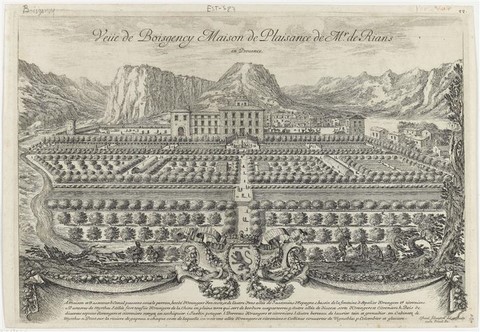
Naturalist

After reading their description by Italian explorer Pietro della Valle in 1620, Peiresc had angora cats (Turkish White) sent to him from Turkey, and bred them, introducing them as luxury pets to Europe. They were an immediate hit. Cardinal Richelieu owned fourteen of them... The "persian" breed was later developed from the angora in Britain...
After his death, Peiresc's scientific estate was for a while kept together by his brother Palamede, but unfortunately, most of it was later dispersed by his nephew. Some of his correspondence was used as wrapping paper...
For those who are interested in reading more about Peiresc, we recommend the website of the "Friends of Peiresc," which carries some articles in english.

